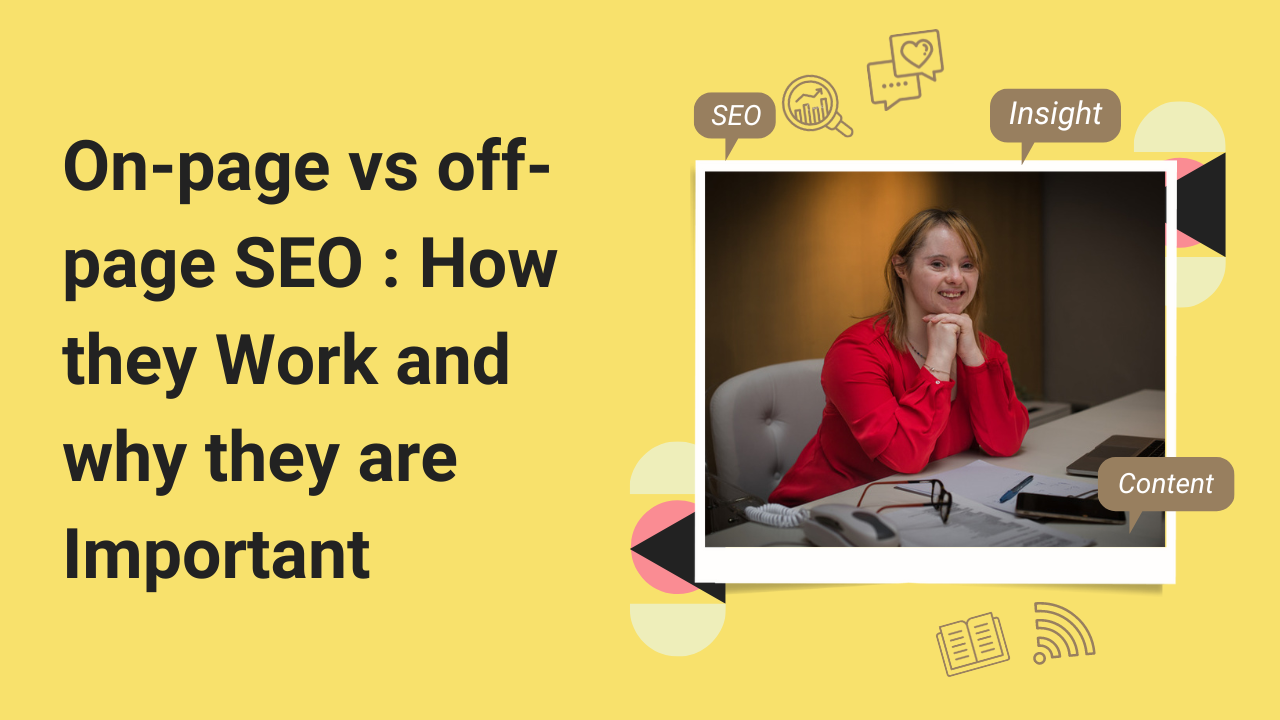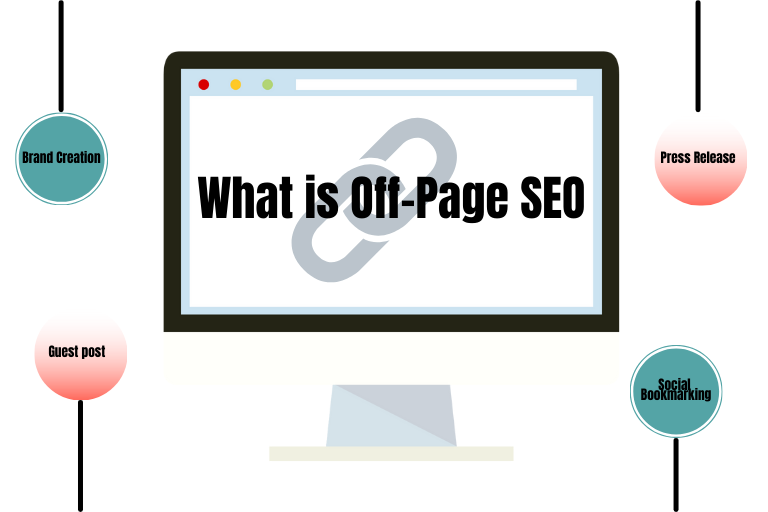
Table of Contents
Google’s search engine algorithm is updated and modified on a constant basis, but one thing remains the same. We cannot focus exclusively on one dimension of SEO and oversimplify it.
A good SEO strategy must address both on-page and off-page optimization.
Listed below is a comprehensive overview of both of these essential SEO approaches as well as best practices that will help you learn more about both and retune your strategy as necessary.
What is the difference between on-page and off-page SEO
What is on-page SEO?
Optimising various parts of your website (also known as “on-site” SEO) can affect how you rank in search engines. Site accessibility, page speed, optimized content, keywords, title tags, and many other factors determine where your website appears in search engine results pages. On-page SEO is all about optimizing those parts of your website that you are in charge of.
Here is an on-page SEO checklist
- Optimize URL
In the search engine results page, concise, descriptive URLs can help users better understand the page’s content.
For example, these two pages are about hair loss
https://www.medicalnewstoday.com/articles/70956
https://www.mayoclinic.org/diseases-conditions/hair-loss/symptoms-causes/syc-20372926
However, that first URL wouldn’t tell you that it is a hair loss article or blog.
In most cases, setting your primary keyword as the URL slug is the best way to create short, descriptive URLs. We do this almost every time we publish a blog post.
https://www.shrushti.com/enterprise-seo-strategy/
https://www.shrushti.com/what-are-redirect-chains-and-loops/
https://www.shrushti.com/page-speed-seo-speed-up-your-website/
The SERPs will abbreviate long URLs, so short URLs are useful.
- Make your title tag compelling
Google’s search results show title tags alongside their URLs, which help users understand what the page is about.
As a rule, you should put your target keyword in your title tags.
If that doesn’t make sense, don’t worry. Writing compelling copy that gets people to click is much more critical.
In most cases, your title will work well.
- Write engaging meta descriptions
A meta description appears approximately 13% of the time in Google’s SERPs.
To write an engaging meta description, we suggest following these tips:
- Describe the title in more detail
- Search intent should be doubled down
- Don’t use passive voice
- Do not exceed 120 characters
- (If it makes sense) Include your primary keyword
- Optimize images
Download image compression plugins on your system. On each page, you should also do the following image optimizations:
Provide a description for each image. Using generic image filenames is not recommended.
Eg: IMG_875939.png or Screenshot-2021–06-01. Such file names should not be used as the SERPs can read them. Instead, try using something like Blue-sky.png or Burj-khalifa.jpg.
Describe the alt text in the image. Alternate text is displayed in place of images that fail to load. Additionally, it can be useful for those who use screen readers.
- Enhance the quality of snippets with schema markup
Rich snippets that appear beneath the title of each page are enhanced with Schema markup, increasing the visibility of your page in SERPs. In order to produce the best possible search results, Google, Bing, Yandex, and Yahoo! have collaborated to develop schema, a way to help you provide the information their search engines need to understand your content.
- Add internal links
Make sure your anchor text is relevant when adding internal links. Usually, the hyperlink’s anchor text (sometimes with blue font color and an underline) is clickable. Choosing the right anchor text means selecting a phrase or word that relates to the page being linked to.
On-page SEO ensures that both search engine robots and potential customers can read your website.
Search engines will find it easier to index your web pages if you have good on-page SEO. If your website is easy to navigate, search engines can easily index your pages, understand what your site is about, and therefore rank your website accordingly. It is recommended to have 1-3 relevant internal links in your page content.
- Webpage content
Page rankings are determined based on whether the pages answer the search query effectively. It means that you have to include valuable information on your page and make it better than any other Google page about it.
Additionally, you must also consider the keyword density on your pages in order to avoid being penalized for stuffing. A keyword density of between 1-2% is considered to be ideal by most SEO experts. As a result, the search term appears about once to twice per 100 words.
In addition, make sure you use your main keyword once in the first 100-150 words of your article. Google gives more weight to keywords that appear early in the post.
You can increase dwell time by optimizing the content on your pages in addition to the structure. The time spent on your page and the bounce rate are important indicators of your page’s performance. To increase dwell time and reduce bounce rate, you can embed videos if the content is too brief.
It is possible that your page’s content isn’t answering your searcher’s query if a visitor spends less than 60 seconds on your page.
- Page load speed
On-page factors in SEO also deal with the structure and quality of your website’s content, as well as your site’s performance (and the pages on it). Users leave and bounce from pages that load slowly or do not look right on mobile, which has a negative impact on rankings.
The size of image files on a page is evaluated by search engines and is used as a ranking factor, so marketers should reduce redirects, make their sites more mobile-friendly, and minimize the use of CSS/Javascript.
What is off page SEO ?
Off-page SEO refers to SEO tactics performed outside your website.
If you want to compete effectively, you will need to apply several off-page SEO tactics. A lot of people assume that building links is all it is, but there is much more to it than that.
The building of citations, content marketing, and social media are all important components of an SEO program.
An easy way of identifying off-page search engine optimization is to say that it involves any method of promoting your own website without updating it.
When search engines recognize these signals, they have better insight into how authoritative your site is, as well as users have a greater sense of confidence.
Here is an off-page SEO checklist

- Assess the quality of backlinks
It is recommended to check your backlink profile using any tool like Ahrefs, Moz. or, Google Search Console
Create a list of domains that link to your site most often, additionally make a list of pages that rake in the most links.
Ahrefs and Moz provide backlink scores based on domain authority or domain rating.
Using one of these free tools, you can evaluate your backlink profile before starting to optimize off-page SEO:
It is also possible to detect backlinks using a paid tool, such as SEMrush.
The tools Ahrefs, Moz, or SEMrush will probably provide you with the most accurate reports for your website. Depending on the tool, you may be able to view or explore a limited amount of data with a free version, for tools such as Moz.
You should be able to access the following information no matter what program you choose:
- Links pointing to your site
- Domains that link to your website
- Amount of links on each page
- Anchor text
Make it easily accessible by exporting this data to an Excel spreadsheet.
You’ll also receive a DA or DR score from a tool like Ahrefs or Moz.
According to the backlink profile of your website, these scores determine the authoritativeness of your website. Scores that are higher are considered to be more authoritative.
As part of its ranking algorithm, Google does not use domain authority or domain reputation to determine a site’s ranking.
- Analyze competitor’s backlink profile
By evaluating competitor backlink profiles, you can get a sense of your own link profile’s strength. As mentioned above, while checking your competition’s backlink profiles, save the data to Google Sheets by using tools such as Ahrefs, Moz, or SEMrush.
The next step is to study the backlink profiles of your competitors.
You can check your competition using Ahrefs, Moz, or SEMrush. Despite this, the Google Search Console cannot be used to research backlink profiles for competitors. Since the data in the Google Search Console can only be accessed by webmasters, only they have access to it.
It is possible that your direct competitors will overlap with your online competitors in certain instances.
For this step to export that data to a sheet that can be compared to get a better assessment.
- Guest posting
In the same way as blogging, it is important to establish your reasons for contributing early on. There are times when guest blogs are used to advertise the businesses or products of their hosts. You should always provide actionable, new, and pertinent information first and not write guest posts in the hopes of getting a backlink.
Writing guest posts periodically will assist not only in building quality backlinks to your website (duh!) but also something else: more organic traffic. By adding comments to others’ blogs as well as your own, you demonstrate a professional attitude.
- Forums
Off-page SEO techniques include marketing your website through forums, and that is a good way to obtain traffic.
You can gain a lot of actionable information and authentic answers to your questions by visiting Quora, Reddit, Yahoo Answers, and how.
You can chat with your peers about topics of interest in forums, where you can meet them and get to know them.
Just as with blog comments or guest posts, you should mention your brand but refrain from being too blunt.
In addition to being true gold mines, Q&A platforms also require success in winning them first, by posting the right words, tonality, and style.
Transparency and relevance are key. The conversion rate of organic traffic is pretty high on these mediums.
- Content Marketing
Content marketing generally can be considered to be just the content you create and publish on your website. A simple SEO tactic, but it is a lot more than just that.
The concept of content marketing, however, encompasses both on and off-page tactics.
Creating and publishing great content anywhere on the web is part of content marketing, as is publishing great content directly on your website.
A guest post on a high-level website, something that simple is content marketing. You created a high-quality and very informative infographic, well that too is content marketing.
Having great, engaging content is appealing since it enables you to focus on off-page factors. A good way to do this is to create great, engaging assets that others want to share and link to — and this is usually done through the promotion of those assets.
Off-page signals can be built by promoting content marketing strategies such as:
- Blog posts
- Whitepapers & eBooks
- Surveys, studies & research papers
- Infographics
Link Building, social media, and public relations are all closely associated with content marketing, and it also helps you build your brand.
It is quite simple: share your great content with the world.
- Local SEO (GMB and Citations)
You can improve your off-page SEO by using trusted local directories and citation sites, Google My Business is one of the best ones. Keep your company info updated across directories using citation management tools like LocalFX to avoid spammy directory sites.
New agencies who have just stepped font into off-site SEO don’t realize that they submit their site to spam-filled and unreliable directories as a link-building strategy.
This does not mean citations and directories should not be included in off-page SEO.
A reputable directory such as Google My Business is useful, as it plays a key role in your local search engine optimization strategy or the visibility of your organization among local search results.
Here are some tips you can use to get started with this strategy:
- Create a list of local and business directory sites that are trustworthy
- Submit your website or a profile for consideration
- Name, address, and phone number (NAP) of your business should be updated.
- Updating information about local citations and directories regularly
You will typically list your business on popular directories, such as Google My Business, Yelp, and Apple Maps. Your off-page SEO may benefit from credible niche directories, however, depending on your industry.
Nonetheless, link building requires continued maintenance, which is one of the challenges.
It’s important to make sure your listing is up-to-date and accurate, just like the one on Google My Business.
It is essential to have the correct information on listings like Google My Business that brings in a lot of traffic. If the information iso. wrong you will lose credibility and leads to
- Social Media
Invest time and energy into social media platforms such as Facebook, Linked In, and Instagram. Publish and promote high-quality content to drive engagement and traffic to your websites, such as studies, tools, and quizzes.
You can share content on social media for free.
Invest some time in social media marketing and social media advertising if you intend to benefit from this off-page SEO strategy and link-building tactic.
Utilizing both of these tactics can help you accumulate more shares and backlinks, which are indicators of a strong online following.
Social media algorithms make it tough for companies to build a social media following online. Nowadays, most algorithms give preference to content from a user’s friends and not the businesses that the user follows.
Advertising on social media and boosting posts on Facebook can bring in a lot of new leads.
Advertisement and boosting can be used by organizations with an existing online presence or those who need to build one. You will, however, be successful if your content is of high quality and adds value to users or has an emotional connection.
It can be extremely effective to promote the following content, for example:
- Research
- The tool
- Take our quiz
- An overview
- Infographic
Share your content on your followers’ social media accounts if you have one.
The fact that you’ve developed a product that your target market will appreciate could result in website traffic, shares, and links when you post about your newest tool.
Congratulations! Our off-page SEO checklist has come to an end. Do you feel ready to begin?
What is more important on-page, off-page SEO, or Technical SEO

On-page SEO or off-page SEO is not comparable to deciding whether to devote your resources to either; that would mean deciding between a roof or a foundation for your house. Your search engine rankings will improve in a complementary fashion if you use both on-page and off-page SEO strategies.
On-page SEO should be your priority first, before turning your attention to off-page SEO.
The foundation needs to be laid before the rest of the house can be constructed, just as you would when you build a house. It is possible to need to make some adjustments to your on-page SEO periodically, just like you do to a foundation.
Why You Need off-page SEO
Search engine rankings will be tough without off-page optimization.
If you don’t do off-page SEO, your site won’t compete with those with more authority because your site won’t be as authoritative. Content from websites with a higher authority tends to rank better than that from those with lower authority.
About the Author
My name’s Semil Shah, and I pride myself on being the last digital marketer that you’ll ever need. Having worked internationally across agile and disruptive teams from San Fransico to London, I can help you take what you are doing in digital to a whole next level.



